Using Security with WebAuthn
This guide demonstrates how your Quarkus application can use WebAuthn authentication instead of passwords.
|
This technology is considered preview. For a full list of possible statuses, check our FAQ entry. |
准备
要完成本指南,您需要:
-
Roughly 15 minutes
-
An IDE
-
JDK 11+ installed with
JAVA_HOMEconfigured appropriately -
Apache Maven 3.9.6
-
Optionally the Quarkus CLI if you want to use it
-
Optionally Mandrel or GraalVM installed and configured appropriately if you want to build a native executable (or Docker if you use a native container build)
Introduction to WebAuthn
WebAuthn is an authentication mechanism designed to replace passwords. In short, every time you write a service for registering new users, or logging them in, instead of asking for a password, you use WebAuthn, which will replace the password.
WebAuthn replaces the password with a proof of identity. In practice, users, instead of having to invent a password, store it or remember it, will use a hardware token that will generate a proof of identity specifically for your service or website. This can be done by asking users to press their thumb on their phone, or pressing a button on a YubiKey on a computer.
So, when you register your user, you use your browser to enter your user information (username, your name, etc…) and instead of typing a password to identify yourself, you click a button which will invoke the WebAuthn browser API which will ask you to do something (press a button, use your fingerprint). Then, your browser will generate a proof of identity which you can send to your service instead of a password.
This proof of identity, when you register, consists mostly in a public key. Actually there’s a lot of stuff in there but the most interesting is the public key. This public key is not stored on your device, or your browser. It is generated especially for the target service (tied to its URI), and derived from the hardware authenticator. So the association of the hardware authenticator and the target service will always derive the same private and public key pair, none of which are stored anywhere. You can for example, take your YubiKey to another computer and it will keep generating the same private/public keys for the same target service.
So, when you register, you send (mostly) a public key instead of a password, and the service stores that information as WebAuthn credentials for your new user account, and this is what will identify you later.
Then, when you need to log in to that service, instead of typing your password (which doesn’t exist, remember?), you press a button on the login form, and the browser will ask you to do something, and then it will send a signature to your service instead of a password. That signature requires the private key that is derived from your authenticator hardware and the target service, and so when your service receives it, it can verify that it corresponds to the signature of the public key you stored as credentials.
So, to recap: registration sends a generated public key instead of a password, and login sends a signature for that public key, allowing you to verify that the user is who they were when they registered.
In practice, it’s a little more complex, because there needs to be a handshake with the server before you can use the hardware authenticator (ask for a challenge and other things), so there are always two calls to your service: one before login or registration, before calling the hardware authenticator, and then the normal login or registration.
And also there are a lot more fields to store than just a public key, but we will help you with that.
架构
In this example, we build a very simple microservice which offers four endpoints:
-
/api/public -
/api/public/me -
/api/users/me -
/api/admin
The /api/public endpoint can be accessed anonymously. The
/api/public/me endpoint can be accessed anonymously and returns the
current username if there is one, or <not logged in> if not. The
/api/admin endpoint is protected with RBAC (Role-Based Access Control)
where only users granted with the admin role can access. At this endpoint,
we use the @RolesAllowed annotation to declaratively enforce the access
constraint. The /api/users/me endpoint is also protected with RBAC
(Role-Based Access Control) where only users granted with the user role
can access. As a response, it returns a JSON document with details about the
user.
完整源码
We recommend that you follow the instructions in the next sections and create the application step by step. However, you can go right to the completed example.
Clone the Git repository: git clone https://github.com/quarkusio/quarkus-quickstarts.git, or download
an archive.
The solution is located in the security-webauthn-quickstart
directory.
Creating the Maven Project
First, we need a new project. Create a new project with the following command:
For Windows users:
-
If using cmd, (don’t use backward slash
\and put everything on the same line) -
If using Powershell, wrap
-Dparameters in double quotes e.g."-DprojectArtifactId=security-webauthn-quickstart"
|
Don’t forget to add the database connector library of choice. Here we are using PostgreSQL as identity store. |
This command generates a Maven project, importing the security-webauthn
extension which allows you to use WebAuthn to authenticate users.
If you already have your Quarkus project configured, you can add the
security-webauthn extension to your project by running the following
command in your project base directory:
quarkus extension add security-webauthn./mvnw quarkus:add-extension -Dextensions='security-webauthn'./gradlew addExtension --extensions='security-webauthn'This will add the following to your build file:
<dependency>
<groupId>io.quarkus</groupId>
<artifactId>quarkus-security-webauthn</artifactId>
</dependency>implementation("io.quarkus:quarkus-security-webauthn")Writing the application
Let’s start by implementing the /api/public endpoint. As you can see from
the source code below, it is just a regular Jakarta REST resource:
package org.acme.security.webauthn;
import java.security.Principal;
import jakarta.ws.rs.GET;
import jakarta.ws.rs.Path;
import jakarta.ws.rs.Produces;
import jakarta.ws.rs.core.Context;
import jakarta.ws.rs.core.MediaType;
import jakarta.ws.rs.core.SecurityContext;
@Path("/api/public")
public class PublicResource {
@GET
@Produces(MediaType.TEXT_PLAIN)
public String publicResource() {
return "public";
}
@GET
@Path("/me")
@Produces(MediaType.TEXT_PLAIN)
public String me(@Context SecurityContext securityContext) {
Principal user = securityContext.getUserPrincipal();
return user != null ? user.getName() : "<not logged in>";
}
}The source code for the /api/admin endpoint is also very simple. The main
difference here is that we are using a @RolesAllowed annotation to make
sure that only users granted with the admin role can access the endpoint:
package org.acme.security.webauthn;
import jakarta.annotation.security.RolesAllowed;
import jakarta.ws.rs.GET;
import jakarta.ws.rs.Path;
import jakarta.ws.rs.Produces;
import jakarta.ws.rs.core.MediaType;
@Path("/api/admin")
public class AdminResource {
@GET
@RolesAllowed("admin")
@Produces(MediaType.TEXT_PLAIN)
public String adminResource() {
return "admin";
}
}Finally, let’s consider the /api/users/me endpoint. As you can see from
the source code below, we are trusting only users with the user role. We
are using SecurityContext to get access to the current authenticated
Principal and we return the user’s name. This information is loaded from the
database.
package org.acme.security.webauthn;
import jakarta.annotation.security.RolesAllowed;
import jakarta.ws.rs.GET;
import jakarta.ws.rs.Path;
import jakarta.ws.rs.core.Context;
import jakarta.ws.rs.core.SecurityContext;
@Path("/api/users")
public class UserResource {
@GET
@RolesAllowed("user")
@Path("/me")
public String me(@Context SecurityContext securityContext) {
return securityContext.getUserPrincipal().getName();
}
}Storing our WebAuthn credentials
We can now describe how our WebAuthn credentials are stored in our database with three entities. Note that we’ve simplified the model in order to only store one credential per user (who could actually have more than one WebAuthn credential and other data such as roles):
package org.acme.security.webauthn;
import java.util.ArrayList;
import java.util.List;
import jakarta.persistence.Entity;
import jakarta.persistence.OneToMany;
import jakarta.persistence.OneToOne;
import jakarta.persistence.Table;
import jakarta.persistence.UniqueConstraint;
import io.quarkus.hibernate.reactive.panache.PanacheEntity;
import io.smallrye.mutiny.Uni;
import io.vertx.ext.auth.webauthn.Authenticator;
import io.vertx.ext.auth.webauthn.PublicKeyCredential;
@Table(uniqueConstraints = @UniqueConstraint(columnNames = {"userName", "credID"}))
@Entity
public class WebAuthnCredential extends PanacheEntity {
/**
* The username linked to this authenticator
*/
public String userName;
/**
* The type of key (must be "public-key")
*/
public String type = "public-key";
/**
* The non user identifiable id for the authenticator
*/
public String credID;
/**
* The public key associated with this authenticator
*/
public String publicKey;
/**
* The signature counter of the authenticator to prevent replay attacks
*/
public long counter;
public String aaguid;
/**
* The Authenticator attestation certificates object, a JSON like:
* <pre>{@code
* {
* "alg": "string",
* "x5c": [
* "base64"
* ]
* }
* }</pre>
*/
/**
* The algorithm used for the public credential
*/
public PublicKeyCredential alg;
/**
* The list of X509 certificates encoded as base64url.
*/
@OneToMany(mappedBy = "webAuthnCredential")
public List<WebAuthnCertificate> x5c = new ArrayList<>();
public String fmt;
// owning side
@OneToOne
public User user;
public WebAuthnCredential() {
}
public WebAuthnCredential(Authenticator authenticator, User user) {
aaguid = authenticator.getAaguid();
if(authenticator.getAttestationCertificates() != null)
alg = authenticator.getAttestationCertificates().getAlg();
counter = authenticator.getCounter();
credID = authenticator.getCredID();
fmt = authenticator.getFmt();
publicKey = authenticator.getPublicKey();
type = authenticator.getType();
userName = authenticator.getUserName();
if(authenticator.getAttestationCertificates() != null
&& authenticator.getAttestationCertificates().getX5c() != null) {
for (String x5c : authenticator.getAttestationCertificates().getX5c()) {
WebAuthnCertificate cert = new WebAuthnCertificate();
cert.x5c = x5c;
cert.webAuthnCredential = this;
this.x5c.add(cert);
}
}
this.user = user;
user.webAuthnCredential = this;
}
public static Uni<List<WebAuthnCredential>> findByUserName(String userName) {
return list("userName", userName);
}
public static Uni<List<WebAuthnCredential>> findByCredID(String credID) {
return list("credID", credID);
}
public <T> Uni<T> fetch(T association) {
return getSession().flatMap(session -> session.fetch(association));
}
}We also need a second entity for the credentials:
package org.acme.security.webauthn;
import jakarta.persistence.Entity;
import jakarta.persistence.ManyToOne;
import io.quarkus.hibernate.reactive.panache.PanacheEntity;
@Entity
public class WebAuthnCertificate extends PanacheEntity {
@ManyToOne
public WebAuthnCredential webAuthnCredential;
/**
* The list of X509 certificates encoded as base64url.
*/
public String x5c;
}And last but not least, our user entity:
package org.acme.security.webauthn;
import jakarta.persistence.Column;
import jakarta.persistence.Entity;
import jakarta.persistence.OneToOne;
import jakarta.persistence.Table;
import io.quarkus.hibernate.reactive.panache.PanacheEntity;
import io.smallrye.mutiny.Uni;
@Table(name = "user_table")
@Entity
public class User extends PanacheEntity {
@Column(unique = true)
public String userName;
// non-owning side, so we can add more credentials later
@OneToOne(mappedBy = "user")
public WebAuthnCredential webAuthnCredential;
public static Uni<User> findByUserName(String userName) {
return find("userName", userName).firstResult();
}
}A note about usernames and credential IDs
WebAuthn relies on a combination of usernames (unique per user) and credential IDs (unique per authenticator device).
The reasons why there are two such identifiers, and why they are not unique keys for the credentials themselves are:
-
A single user can have more than one authenticator device, which means a single username can map to multiple credential IDs, all of which identify the same user.
-
An authenticator device may be shared by multiple users, because a single person may want multiple user accounts with different usernames, all of which having the same authenticator device. So a single credential ID may be used by multiple different users.
The combination of username and credential ID should be a unicity constraint for your credentials table, though.
Exposing your entities to Quarkus WebAuthn
You need to define a bean implementing the WebAuthnUserProvider in order
to allow the Quarkus WebAuthn extension to load and store credentials. This
is where you tell Quarkus how to turn your data model into the WebAuthn
security model:
package org.acme.security.webauthn;
import java.util.ArrayList;
import java.util.Collections;
import java.util.HashSet;
import java.util.List;
import java.util.Set;
import jakarta.enterprise.context.ApplicationScoped;
import io.quarkus.hibernate.reactive.panache.common.runtime.ReactiveTransactional;
import io.quarkus.security.webauthn.WebAuthnUserProvider;
import io.smallrye.mutiny.Uni;
import io.vertx.ext.auth.webauthn.AttestationCertificates;
import io.vertx.ext.auth.webauthn.Authenticator;
@ApplicationScoped
public class MyWebAuthnSetup implements WebAuthnUserProvider {
@ReactiveTransactional
@Override
public Uni<List<Authenticator>> findWebAuthnCredentialsByUserName(String userName) {
return WebAuthnCredential.findByUserName(userName)
.flatMap(MyWebAuthnSetup::toAuthenticators);
}
@ReactiveTransactional
@Override
public Uni<List<Authenticator>> findWebAuthnCredentialsByCredID(String credID) {
return WebAuthnCredential.findByCredID(credID)
.flatMap(MyWebAuthnSetup::toAuthenticators);
}
@ReactiveTransactional
@Override
public Uni<Void> updateOrStoreWebAuthnCredentials(Authenticator authenticator) {
return User.findByUserName(authenticator.getUserName())
.flatMap(user -> {
// new user
if(user == null) {
User newUser = new User();
newUser.userName = authenticator.getUserName();
WebAuthnCredential credential = new WebAuthnCredential(authenticator, newUser);
return credential.persist()
.flatMap(c -> newUser.persist())
.onItem().ignore().andContinueWithNull();
} else {
// existing user
user.webAuthnCredential.counter = authenticator.getCounter();
return Uni.createFrom().nullItem();
}
});
}
private static Uni<List<Authenticator>> toAuthenticators(List<WebAuthnCredential> dbs) {
// can't call combine/uni on empty list
if(dbs.isEmpty())
return Uni.createFrom().item(Collections.emptyList());
List<Uni<Authenticator>> ret = new ArrayList<>(dbs.size());
for (WebAuthnCredential db : dbs) {
ret.add(toAuthenticator(db));
}
return Uni.combine().all().unis(ret).combinedWith(f -> (List)f);
}
private static Uni<Authenticator> toAuthenticator(WebAuthnCredential credential) {
return credential.fetch(credential.x5c)
.map(x5c -> {
Authenticator ret = new Authenticator();
ret.setAaguid(credential.aaguid);
AttestationCertificates attestationCertificates = new AttestationCertificates();
attestationCertificates.setAlg(credential.alg);
List<String> x5cs = new ArrayList<>(x5c.size());
for (WebAuthnCertificate webAuthnCertificate : x5c) {
x5cs.add(webAuthnCertificate.x5c);
}
ret.setAttestationCertificates(attestationCertificates);
ret.setCounter(credential.counter);
ret.setCredID(credential.credID);
ret.setFmt(credential.fmt);
ret.setPublicKey(credential.publicKey);
ret.setType(credential.type);
ret.setUserName(credential.userName);
return ret;
});
}
@Override
public Set<String> getRoles(String userId) {
if(userId.equals("admin")) {
Set<String> ret = new HashSet<>();
ret.add("user");
ret.add("admin");
return ret;
}
return Collections.singleton("user");
}
}Writing the HTML application
We now need to write a web page with links to all our APIs, as well as a way
to register a new user, login, and logout, in
src/main/resources/META-INF/resources/index.html:
<!DOCTYPE html>
<html lang="en">
<head>
<meta charset="UTF-8">
<title>Login</title>
<script src="/q/webauthn/webauthn.js" type="text/javascript" charset="UTF-8"></script>
<style>
.container {
display: grid;
grid-template-columns: auto auto auto;
}
button, input {
margin: 5px 0;
}
.item {
padding: 20px;
}
nav > ul {
list-style-type: none;
margin: 0;
padding: 0;
overflow: hidden;
background-color: #333;
}
nav > ul > li {
float: left;
}
nav > ul > li > a {
display: block;
color: white;
text-align: center;
padding: 14px 16px;
text-decoration: none;
}
nav > ul > li > a:hover {
background-color: #111;
}
</style>
</head>
<body>
<nav>
<ul>
<li><a href="/api/public">Public API</a></li>
<li><a href="/api/users/me">User API</a></li>
<li><a href="/api/admin">Admin API</a></li>
<li><a href="/q/webauthn/logout">Logout</a></li>
</nav>
<div class="container">
<div class="item">
<h1>Status</h1>
<div id="result"></div>
</div>
<div class="item">
<h1>Login</h1>
<p>
<input id="userNameLogin" placeholder="User name"/><br/>
<button id="login">Login</button>
</p>
</div>
<div class="item">
<h1>Register</h1>
<p>
<input id="userNameRegister" placeholder="User name"/><br/>
<input id="firstName" placeholder="First name"/><br/>
<input id="lastName" placeholder="Last name"/><br/>
<button id="register">Register</button>
</p>
</div>
</div>
<script type="text/javascript">
const webAuthn = new WebAuthn({
callbackPath: '/q/webauthn/callback',
registerPath: '/q/webauthn/register',
loginPath: '/q/webauthn/login'
});
const result = document.getElementById('result');
fetch('/api/public/me')
.then(response => response.text())
.then(name => result.append("User: "+name));
const loginButton = document.getElementById('login');
loginButton.onclick = () => {
var userName = document.getElementById('userNameLogin').value;
result.replaceChildren();
webAuthn.login({ name: userName })
.then(body => {
result.append("User: "+userName);
})
.catch(err => {
result.append("Login failed: "+err);
});
return false;
};
const registerButton = document.getElementById('register');
registerButton.onclick = () => {
var userName = document.getElementById('userNameRegister').value;
var firstName = document.getElementById('firstName').value;
var lastName = document.getElementById('lastName').value;
result.replaceChildren();
webAuthn.register({ name: userName, displayName: firstName + " " + lastName })
.then(body => {
result.append("User: "+userName);
})
.catch(err => {
result.append("Registration failed: "+err);
});
return false;
};
</script>
</body>
</html>Testing the application
The application is now protected and the identities are provided by our database.
Run your application in dev mode with:
quarkus dev./mvnw quarkus:dev./gradlew --console=plain quarkusDevwhich will start a PostgreSQL Dev Service container, and open http://localhost:8080 in your browser.
Initially, you will have no credentials registered, and no current user:
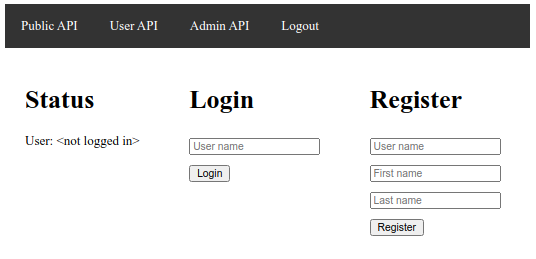
The current user is displayed on the left, and you can use the top menu to try accessing the public API, which should work, while the user and admin APIs will fail and redirect you to the current page.
Start by registering your WebAuthn credentials by entering a username, first
and last names on the Register form on the right, then pressing the
Register button:
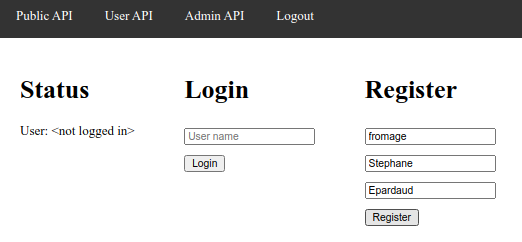
Your browser will ask you to activate your WebAuthn authenticator:
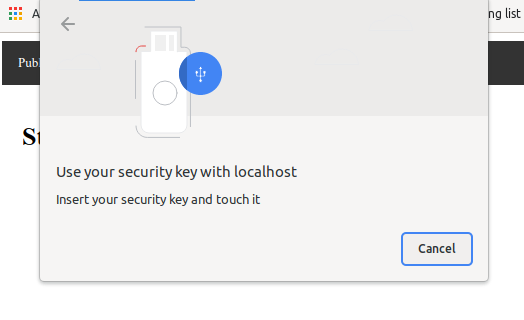
You will then be logged in, and can check that the user API is now accessible:
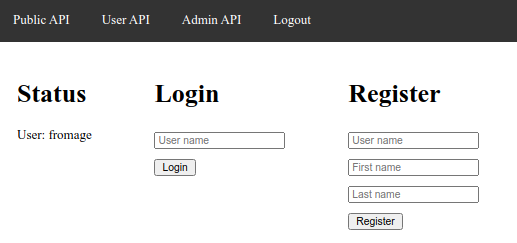
At this stage you can Logout and enter your username in the Login form:
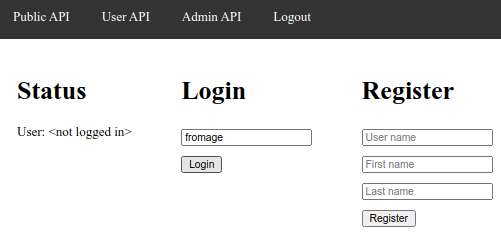
Then press the Login button, and you will be logged in:

The admin API is only accessible if you register with the admin user name.
WebAuthn endpoints
The Quarkus WebAuthn extension comes out of the box with these REST endpoints pre-defined:
Obtain a registration challenge
POST /q/webauthn/register: Set up and obtain a registration challenge
{
"name": "userName",
"displayName": "Mr Nice Guy"
}{
"rp": {
"name": "Quarkus server"
},
"user": {
"id": "ryPi43NJSx6LFYNitrOvHg",
"name": "FroMage",
"displayName": "Mr Nice Guy"
},
"challenge": "6tkVLgYzp5yJz_MtnzCy6VRMkHuN4f4C-_hukRmsuQ_MQl7uxJweiqH8gaFkm_mEbKzlUbOabJM3nLbi08i1Uw",
"pubKeyCredParams": [
{
"alg": -7,
"type":"public-key"
},
{
"alg": -257,
"type": "public-key"
}
],
"authenticatorSelection": {
"requireResidentKey": false,
"userVerification": "discouraged"
},
"timeout": 60000,
"attestation": "none",
"extensions": {
"txAuthSimple": ""
}
}Obtain a login challenge
POST /q/webauthn/login: Set up and obtain a login challenge
{
"name": "userName"
}{
"challenge": "RV4hqKHezkWSxpOICBkpx16yPJFGMZrkPlJP-Wp8w4rVl34VIzCT7AP0Q5Rv-3JCU3jwu-j3VlOgyNMDk2AqDg",
"timeout": 60000,
"userVerification": "discouraged",
"extensions": {
"txAuthSimple": ""
},
"allowCredentials": [
{
"type": "public-key",
"id": "boMwU-QwZ_RsToPTG3iC50g8-yiKbLc3A53tgWMhzbNEQAJIlbWgchmwbt5m0ssqQNR0IM_WxCmcfKWlEao7Fg",
"transports": [
"usb",
"nfc",
"ble",
"internal"
]
}
]
}Trigger a registration
POST /q/webauthn/callback: Trigger a registration
{
"id": "boMwU-QwZ_RsToPTG3iC50g8-yiKbLc3A53tgWMhzbNEQAJIlbWgchmwbt5m0ssqQNR0IM_WxCmcfKWlEao7Fg",
"rawId": "boMwU-QwZ_RsToPTG3iC50g8-yiKbLc3A53tgWMhzbNEQAJIlbWgchmwbt5m0ssqQNR0IM_WxCmcfKWlEao7Fg",
"response": {
"attestationObject": "<DATA>",
"clientDataJSON":"<DATA>"
},
"type": "public-key"
}This returns a 204 with no body.
Trigger a login
POST /q/webauthn/callback: Trigger a login
{
"id": "boMwU-QwZ_RsToPTG3iC50g8-yiKbLc3A53tgWMhzbNEQAJIlbWgchmwbt5m0ssqQNR0IM_WxCmcfKWlEao7Fg",
"rawId": "boMwU-QwZ_RsToPTG3iC50g8-yiKbLc3A53tgWMhzbNEQAJIlbWgchmwbt5m0ssqQNR0IM_WxCmcfKWlEao7Fg",
"response": {
"clientDataJSON": "<DATA>",
"authenticatorData": "<DATA>",
"signature": "<DATA>",
"userHandle": ""
},
"type": "public-key"
}This returns a 204 with no body.
WebAuthn JavaScript library
Because there’s so much JavaScript needed to set WebAuthn up in the browser,
the Quarkus WebAuthn extension ships with a JavaScript library to help you
talk to the WebAuthn endpoints, at /q/webauthn/webauthn.js. You can set it
up like this:
<script src="/q/webauthn/webauthn.js" type="text/javascript" charset="UTF-8"></script>
<script type="text/javascript">
// configure where our endpoints are
const webAuthn = new WebAuthn({
callbackPath: '/q/webauthn/callback',
registerPath: '/q/webauthn/register',
loginPath: '/q/webauthn/login'
});
// use the webAuthn APIs here
</script>Invoke registration
The webAuthn.register method invokes the registration challenge endpoint,
then calls the authenticator and invokes the callback endpoint for that
registration, and returns a
Promise
object:
webAuthn.register({ name: userName, displayName: firstName + " " + lastName })
.then(body => {
// do something now that the user is registered
})
.catch(err => {
// registration failed
});Invoke login
The webAuthn.login method invokes the login challenge endpoint, then calls
the authenticator and invokes the callback endpoint for that login, and
returns a
Promise
object:
webAuthn.login({ name: userName })
.then(body => {
// do something now that the user is logged in
})
.catch(err => {
// login failed
});Only invoke the registration challenge and authenticator
The webAuthn.registerOnly method invokes the registration challenge
endpoint, then calls the authenticator and returns a
Promise
object containing a JSON object suitable for being sent to the callback
endpoint. You can use that JSON object in order to store the credentials in
hidden form input elements, for example, and send it as part of a regular
HTML form:
webAuthn.registerOnly({ name: userName, displayName: firstName + " " + lastName })
.then(body => {
// store the registration JSON in form elements
document.getElementById('webAuthnId').value = body.id;
document.getElementById('webAuthnRawId').value = body.rawId;
document.getElementById('webAuthnResponseAttestationObject').value = body.response.attestationObject;
document.getElementById('webAuthnResponseClientDataJSON').value = body.response.clientDataJSON;
document.getElementById('webAuthnType').value = body.type;
})
.catch(err => {
// registration failed
});Only invoke the login challenge and authenticator
The webAuthn.loginOnly method invokes the login challenge endpoint, then
calls the authenticator and returns a
Promise
object containing a JSON object suitable for being sent to the callback
endpoint. You can use that JSON object in order to store the credentials in
hidden form input elements, for example, and send it as part of a regular
HTML form:
webAuthn.loginOnly({ name: userName })
.then(body => {
// store the login JSON in form elements
document.getElementById('webAuthnId').value = body.id;
document.getElementById('webAuthnRawId').value = body.rawId;
document.getElementById('webAuthnResponseClientDataJSON').value = body.response.clientDataJSON;
document.getElementById('webAuthnResponseAuthenticatorData').value = body.response.authenticatorData;
document.getElementById('webAuthnResponseSignature').value = body.response.signature;
document.getElementById('webAuthnResponseUserHandle').value = body.response.userHandle;
document.getElementById('webAuthnType').value = body.type;
})
.catch(err => {
// login failed
});Handling login and registration endpoints yourself
Sometimes, you will want to ask for more data than just a username in order to register a user, or you want to deal with login and registration with custom validation, and so the WebAuthn callback endpoint is not enough.
In this case, you can use the WebAuthn.loginOnly and
WebAuthn.registerOnly methods from the JavaScript library, store the
authenticator data in hidden form elements, and send them as part of your
form payload to the server to your custom login or registration endpoints.
If you are storing them in form input elements, you can then use the
WebAuthnLoginResponse and WebAuthnRegistrationResponse classes, mark
them as @BeanParam and then use the WebAuthnSecurity.login and
WebAuthnSecurity.register methods. For example, here’s how you can handle
a custom login and register:
package org.acme.security.webauthn;
import java.net.URI;
import jakarta.inject.Inject;
import jakarta.ws.rs.BeanParam;
import jakarta.ws.rs.POST;
import jakarta.ws.rs.Path;
import jakarta.ws.rs.core.NewCookie;
import jakarta.ws.rs.core.Response;
import jakarta.ws.rs.core.Response.Status;
import org.jboss.resteasy.reactive.RestForm;
import io.quarkus.hibernate.reactive.panache.common.runtime.ReactiveTransactional;
import io.quarkus.security.webauthn.WebAuthnLoginResponse;
import io.quarkus.security.webauthn.WebAuthnRegisterResponse;
import io.quarkus.security.webauthn.WebAuthnSecurity;
import io.smallrye.mutiny.Uni;
import io.vertx.ext.auth.webauthn.Authenticator;
import io.vertx.ext.web.RoutingContext;
@Path("")
public class LoginResource {
@Inject
WebAuthnSecurity webAuthnSecurity;
@Path("/login")
@POST
@ReactiveTransactional
public Uni<Response> login(@RestForm String userName,
@BeanParam WebAuthnLoginResponse webAuthnResponse,
RoutingContext ctx) {
// Input validation
if(userName == null || userName.isEmpty()
|| !webAuthnResponse.isSet()
|| !webAuthnResponse.isValid()) {
return Uni.createFrom().item(Response.status(Status.BAD_REQUEST).build());
}
Uni<User> userUni = User.findByUserName(userName);
return userUni.flatMap(user -> {
if(user == null) {
// Invalid user
return Uni.createFrom().item(Response.status(Status.BAD_REQUEST).build());
}
Uni<Authenticator> authenticator = this.webAuthnSecurity.login(webAuthnResponse, ctx);
return authenticator
// bump the auth counter
.invoke(auth -> user.webAuthnCredential.counter = auth.getCounter())
.map(auth -> {
// make a login JWT cookie
NewCookie cookie = null;
return Response.seeOther(URI.create("/")).cookie(cookie).build();
})
// handle login failure
.onFailure().recoverWithItem(x -> {
// make a proper error response
return Response.status(Status.BAD_REQUEST).build();
});
});
}
@Path("/register")
@POST
@ReactiveTransactional
public Uni<Response> register(@RestForm String userName,
@BeanParam WebAuthnRegisterResponse webAuthnResponse,
RoutingContext ctx) {
// Input validation
if(userName == null || userName.isEmpty()
|| !webAuthnResponse.isSet()
|| !webAuthnResponse.isValid()) {
return Uni.createFrom().item(Response.status(Status.BAD_REQUEST).build());
}
Uni<User> userUni = User.findByUserName(userName);
return userUni.flatMap(user -> {
if(user != null) {
// Duplicate user
return Uni.createFrom().item(Response.status(Status.BAD_REQUEST).build());
}
Uni<Authenticator> authenticator = this.webAuthnSecurity.register(webAuthnResponse, ctx);
return authenticator
// store the user
.flatMap(auth -> {
User newUser = new User();
newUser.userName = auth.getUserName();
WebAuthnCredential credential = new WebAuthnCredential(auth, newUser);
return credential.persist()
.flatMap(c -> newUser.persist());
})
.map(newUser -> {
// make a login JWT cookie
NewCookie cookie = null;
return Response.seeOther(URI.create("/")).cookie(cookie).build();
})
// handle login failure
.onFailure().recoverWithItem(x -> {
// make a proper error response
return Response.status(Status.BAD_REQUEST).build();
});
});
}
}
The WebAuthnSecurity methods do not set or read the user cookie, so you
will have to take care of it yourself, but it allows you to use other means
of storing the user, such as JWT. You can use the rememberUser(String
userName, RoutingContext ctx) and logout(RoutingContext ctx) methods on
the same WebAuthnSecurity class if you want to manually set up login
cookies.
|
Blocking version
If you’re using a blocking data access to the database, you can safely block
on the WebAuthnSecurity methods, with .await().indefinitely(), because
nothing is async in the register and login methods, besides the data
access with your WebAuthnUserProvider.
You will have to add the @Blocking annotation on your
WebAuthnUserProvider class in order to tell the Quarkus WebAuthn endpoints
to defer those calls to the worker pool.
Testing WebAuthn
Testing WebAuthn can be complicated because normally you need a hardware
token, which is why we’ve made the quarkus-test-security-webauthn helper
library:
<dependency>
<groupId>io.quarkus</groupId>
<artifactId>quarkus-test-security-webauthn</artifactId>
</dependency>implementation("io.quarkus:quarkus-test-security-webauthn")With this, you can use WebAuthnHardware to emulate an authenticator token,
as well as the WebAuthnEndpointHelper helper methods in order to invoke
the WebAuthn endpoints, or even fill your form data for custom endpoints:
package org.acme.security.webauthn.test;
import static io.restassured.RestAssured.given;
import java.util.function.Consumer;
import java.util.function.Supplier;
import org.hamcrest.Matchers;
import org.junit.jupiter.api.Test;
import io.quarkus.security.webauthn.WebAuthnController;
import io.quarkus.test.junit.QuarkusTest;
import io.quarkus.test.security.webauthn.WebAuthnEndpointHelper;
import io.quarkus.test.security.webauthn.WebAuthnHardware;
import io.restassured.RestAssured;
import io.restassured.filter.Filter;
import io.restassured.http.ContentType;
import io.restassured.specification.RequestSpecification;
import io.vertx.core.json.JsonObject;
@QuarkusTest
public class WebAuthnResourceTest {
enum User {
USER, ADMIN;
}
enum Endpoint {
DEFAULT, MANUAL;
}
@Test
public void testWebAuthnUser() {
testWebAuthn("FroMage", User.USER, Endpoint.DEFAULT);
testWebAuthn("scooby", User.USER, Endpoint.MANUAL);
}
@Test
public void testWebAuthnAdmin() {
testWebAuthn("admin", User.ADMIN, Endpoint.DEFAULT);
}
private void testWebAuthn(String userName, User user, Endpoint endpoint) {
Filter cookieFilter = new RenardeCookieFilter();
WebAuthnHardware token = new WebAuthnHardware();
verifyLoggedOut(cookieFilter);
// two-step registration
String challenge = WebAuthnEndpointHelper.invokeRegistration(userName, cookieFilter);
JsonObject registrationJson = token.makeRegistrationJson(challenge);
if(endpoint == Endpoint.DEFAULT)
WebAuthnEndpointHelper.invokeCallback(registrationJson, cookieFilter);
else {
invokeCustomEndpoint("/register", cookieFilter, request -> {
WebAuthnEndpointHelper.addWebAuthnRegistrationFormParameters(request, registrationJson);
request.formParam("userName", userName);
});
}
// verify that we can access logged-in endpoints
verifyLoggedIn(cookieFilter, userName, user);
// logout
WebAuthnEndpointHelper.invokeLogout(cookieFilter);
verifyLoggedOut(cookieFilter);
// two-step login
challenge = WebAuthnEndpointHelper.invokeLogin(userName, cookieFilter);
JsonObject loginJson = token.makeLoginJson(challenge);
if(endpoint == Endpoint.DEFAULT)
WebAuthnEndpointHelper.invokeCallback(loginJson, cookieFilter);
else {
invokeCustomEndpoint("/login", cookieFilter, request -> {
WebAuthnEndpointHelper.addWebAuthnLoginFormParameters(request, loginJson);
request.formParam("userName", userName);
});
}
// verify that we can access logged-in endpoints
verifyLoggedIn(cookieFilter, userName, user);
// logout
WebAuthnEndpointHelper.invokeLogout(cookieFilter);
verifyLoggedOut(cookieFilter);
}
private void invokeCustomEndpoint(String uri, Filter cookieFilter, Consumer<RequestSpecification> requestCustomiser) {
RequestSpecification request = given()
.when();
requestCustomiser.accept(request);
request
.filter(cookieFilter)
.redirects().follow(false)
.log().ifValidationFails()
.post(uri)
.then()
.statusCode(200)
.log().ifValidationFails()
.cookie(WebAuthnController.CHALLENGE_COOKIE, Matchers.is(""))
.cookie(WebAuthnController.USERNAME_COOKIE, Matchers.is(""))
.cookie("quarkus-credential", Matchers.notNullValue());
}
private void verifyLoggedIn(Filter cookieFilter, String userName, User user) {
// public API still good
RestAssured.given().filter(cookieFilter)
.when()
.get("/api/public")
.then()
.statusCode(200)
.body(Matchers.is("public"));
// public API user name
RestAssured.given().filter(cookieFilter)
.when()
.get("/api/public/me")
.then()
.statusCode(200)
.body(Matchers.is(userName));
// user API accessible
RestAssured.given().filter(cookieFilter)
.when()
.get("/api/users/me")
.then()
.statusCode(200)
.body(Matchers.is(userName));
// admin API?
if(user == User.ADMIN) {
RestAssured.given().filter(cookieFilter)
.when()
.get("/api/admin")
.then()
.statusCode(200)
.body(Matchers.is("admin"));
} else {
RestAssured.given().filter(cookieFilter)
.when()
.get("/api/admin")
.then()
.statusCode(403);
}
}
private void verifyLoggedOut(Filter cookieFilter) {
// public API still good
RestAssured.given().filter(cookieFilter)
.when()
.get("/api/public")
.then()
.statusCode(200)
.body(Matchers.is("public"));
// public API user name
RestAssured.given().filter(cookieFilter)
.when()
.get("/api/public/me")
.then()
.statusCode(200)
.body(Matchers.is("<not logged in>"));
// user API not accessible
RestAssured.given()
.filter(cookieFilter)
.redirects().follow(false)
.when()
.get("/api/users/me")
.then()
.statusCode(302)
.header("Location", Matchers.is("http://localhost:8081/"));
// admin API not accessible
RestAssured.given()
.filter(cookieFilter)
.redirects().follow(false)
.when()
.get("/api/admin")
.then()
.statusCode(302)
.header("Location", Matchers.is("http://localhost:8081/"));
}
}For this test, since we’re testing both the provided callback endpoint,
which updates users in its WebAuthnUserProvider and the manual
LoginResource endpoint, which deals with users manually, we need to
override the WebAuthnUserProvider with one that doesn’t update the
scooby user:
package org.acme.security.webauthn.test;
import jakarta.enterprise.context.ApplicationScoped;
import org.acme.security.webauthn.MyWebAuthnSetup;
import io.quarkus.test.Mock;
import io.smallrye.mutiny.Uni;
import io.vertx.ext.auth.webauthn.Authenticator;
@Mock
@ApplicationScoped
public class TestUserProvider extends MyWebAuthnSetup {
@Override
public Uni<Void> updateOrStoreWebAuthnCredentials(Authenticator authenticator) {
// delegate the scooby user to the manual endpoint, because if we do it here it will be
// created/updated twice
if(authenticator.getUserName().equals("scooby"))
return Uni.createFrom().nullItem();
return super.updateOrStoreWebAuthnCredentials(authenticator);
}
}Configuration Reference
Configuration property fixed at build time - All other configuration properties are overridable at runtime
Type |
Default |
|
|---|---|---|
If the WebAuthn extension is enabled. Environment variable: Show more |
boolean |
|
The origin of the application. The origin is basically protocol, host and port. If you are calling WebAuthn API while your application is located at Environment variable: Show more |
string |
|
Authenticator Transports allowed by the application. Authenticators can interact with the user web browser through several transports. Applications may want to restrict the transport protocols for extra security hardening reasons. By default, all transports should be allowed. If your application is to be used by mobile phone users, you may want to restrict only the
Environment variable: Show more |
list of AuthenticatorTransport |
|
The id (or domain name of your server) Environment variable: Show more |
string |
|
A user friendly name for your server Environment variable: Show more |
string |
|
Kind of Authenticator Attachment allowed. Authenticators can connect to your device in two forms:
Environment variable: Show more |
|
|
Resident key required. A resident (private) key, is a key that cannot leave your authenticator device, this means that you cannot reuse the authenticator to log into a second computer. Environment variable: Show more |
boolean |
|
User Verification requirements. Webauthn applications may choose
Environment variable: Show more |
|
|
Non-negative User Verification timeout. Authentication must occur within the timeout, this will prevent the user browser from being blocked with a pop-up required user verification, and the whole ceremony must be completed within the timeout period. After the timeout, any previously issued challenge is automatically invalidated. Environment variable: Show more |
|
|
Device Attestation Preference. During registration, applications may want to attest the device. Attestation is a cryptographic verification of the authenticator hardware. Attestation implies that the privacy of the users may be exposed and browsers might override the desired configuration on the user’s behalf. Valid values are:
Environment variable: Show more |
|
|
Allowed Public Key Credential algorithms by preference order. Webauthn mandates that all authenticators must support at least the following 2 algorithms: Environment variable: Show more |
list of PublicKeyCredential |
|
Length of the challenges exchanged between the application and the browser. Challenges must be at least 32 bytes. Environment variable: Show more |
int |
|
The login page Environment variable: Show more |
string |
|
The inactivity (idle) timeout When inactivity timeout is reached, cookie is not renewed and a new login is enforced. Environment variable: Show more |
|
|
How old a cookie can get before it will be replaced with a new cookie with an updated timeout, also referred to as "renewal-timeout". Note that smaller values will result in slightly more server load (as new encrypted cookies will be generated more often), however larger values affect the inactivity timeout as the timeout is set when a cookie is generated. For example if this is set to 10 minutes, and the inactivity timeout is 30m, if a users last request is when the cookie is 9m old then the actual timeout will happen 21m after the last request, as the timeout is only refreshed when a new cookie is generated. In other words, no timeout is tracked on the server side; the timestamp is encoded and encrypted in the cookie itself, and it is decrypted and parsed with each request. Environment variable: Show more |
|
|
The cookie that is used to store the persistent session Environment variable: Show more |
string |
|
SameSite attribute for the session cookie. Environment variable: Show more |
|
|
The cookie path for the session cookies. Environment variable: Show more |
string |
|
|
About the Duration format
To write duration values, use the standard You can also use a simplified format, starting with a number:
In other cases, the simplified format is translated to the
|

